The following article comes from the LoosCo.com Aircraft Cable Restoration Department. When the Parish Clock in Weston, VT needed repair, we were there to lend a helping hand (and a little elbow grease as well!). Richard Griswold, our president and a native of Vermont, volunteered his time and a reel of our aircraft cable to help with the restoration. Here’s the story told by Richard himself…
Letter from John Soderberg
 When the letter from John Soderberg arrived at Loos & Co., Inc. in early August it was not addressed to anyone in particular so, as is the rule, it went to Laura Taylor for distribution. After reading the letter describing the need for 75 feet of cable for a tower clock restoration project Laura knew exactly who to forward the letter to. For the past few years my interest in old mechanical clocks has grown to the point where I’ve taken a couple of courses on clock repair and actually mended a few clocks that, as is the norm, had stopped running for various reasons, although usually only because they needed a good cleaning, oiling and adjustment. I’d certainly never dealt with anything as large as a tower clock so I was immediately interested.
When the letter from John Soderberg arrived at Loos & Co., Inc. in early August it was not addressed to anyone in particular so, as is the rule, it went to Laura Taylor for distribution. After reading the letter describing the need for 75 feet of cable for a tower clock restoration project Laura knew exactly who to forward the letter to. For the past few years my interest in old mechanical clocks has grown to the point where I’ve taken a couple of courses on clock repair and actually mended a few clocks that, as is the norm, had stopped running for various reasons, although usually only because they needed a good cleaning, oiling and adjustment. I’d certainly never dealt with anything as large as a tower clock so I was immediately interested.
George Stevens Clocks
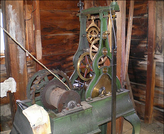 In his letter John described the tower clock in the Weston, Vermont Old Parish Church as a George Stevens’ clock that was installed in 1882 and had worn pulleys and cable that needed replacement. Not being familiar with tower clock manufacturers I searched George Stevens on the Internet and found that he was in fact quite a prolific builder and installer of tower clocks throughout New England, New York and Pennsylvania during the late 19th and early 20th centuries. According to the web site, among the locations his clocks can be found are Hartford and Putnam, CT; Southbridge and Sturbridge, MA (Old Sturbridge Village?); and Johnson, VT where I grew up and attended elementary and high school. I emailed John to tell him he had indeed struck pay dirt since not only could Loos & Company manufacture the cable, but as a Vermont native and amateur clockmaker I would actually be excited to be of assistance to him.
In his letter John described the tower clock in the Weston, Vermont Old Parish Church as a George Stevens’ clock that was installed in 1882 and had worn pulleys and cable that needed replacement. Not being familiar with tower clock manufacturers I searched George Stevens on the Internet and found that he was in fact quite a prolific builder and installer of tower clocks throughout New England, New York and Pennsylvania during the late 19th and early 20th centuries. According to the web site, among the locations his clocks can be found are Hartford and Putnam, CT; Southbridge and Sturbridge, MA (Old Sturbridge Village?); and Johnson, VT where I grew up and attended elementary and high school. I emailed John to tell him he had indeed struck pay dirt since not only could Loos & Company manufacture the cable, but as a Vermont native and amateur clockmaker I would actually be excited to be of assistance to him.
Loos Manufactures the Cable
 Based on John’s description of the cable I thought it likely to be 7X7 construction but was uncertain of the material since John thought it was perhaps original to the clock. A week later a sample arrived in the mail and was immediately passed to Curtis Schopfer for analysis. Curtis determined the cable to be 3/16” 7X7 GAC with a fiber core, not original to the clock which would have been produced of iron strand in 1882. Fortunately, Loos was running 7X7 GAC with polypropylene core in a couple of weeks so an additional 100 feet was added to that order. John was also curious as to lubrication to be used on the cable. He indicated he had plenty of motor oil if that was appropriate, which Curtis confirmed was most certainly not. A query to Grignard, Loos’ lube distributor, indicated the right material would be their synthetic Prelube-6 and they were happy to provide a few aerosol cans for the project. (Wonder if this will work well on springs for smaller wall and mantel clocks? We’ll soon see!) Curtis points out the lube likely to have been used on the original iron cable would have been animal fat.
Based on John’s description of the cable I thought it likely to be 7X7 construction but was uncertain of the material since John thought it was perhaps original to the clock. A week later a sample arrived in the mail and was immediately passed to Curtis Schopfer for analysis. Curtis determined the cable to be 3/16” 7X7 GAC with a fiber core, not original to the clock which would have been produced of iron strand in 1882. Fortunately, Loos was running 7X7 GAC with polypropylene core in a couple of weeks so an additional 100 feet was added to that order. John was also curious as to lubrication to be used on the cable. He indicated he had plenty of motor oil if that was appropriate, which Curtis confirmed was most certainly not. A query to Grignard, Loos’ lube distributor, indicated the right material would be their synthetic Prelube-6 and they were happy to provide a few aerosol cans for the project. (Wonder if this will work well on springs for smaller wall and mantel clocks? We’ll soon see!) Curtis points out the lube likely to have been used on the original iron cable would have been animal fat.
Route 101, Weston & the Country Store
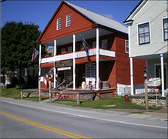 Often described as one of the most scenic routes in New England, if not the entire country, Route 100 winds its way for 217 miles from the southern border of Vermont on the Massachusetts line to within 10 miles of its northern border with Canada. Much of the road follows old footpaths twisting and turning alongside rivers running beside and through the Green Mountain National Forest. Farms and small villages abound along the route, and since it runs mostly through the center of the State, it’s far enough from the western and eastern borders to avoid the clutter than comes with the interstate highways. Many of the classic villages that Route 100 runs through are well known for their inns, country stores, and restaurants. Weston, located in the southern part of the State, is one of the prettiest, and has one of the most famous country stores in New England, aptly named the Vermont Country Store. The store sells hard to find items that you might have seen in your grandparents’ or great-grandparents’ house; everything from cast iron goods to lifebuoy soap to flannel sheets, as well as more everyday items including a variety of Vermont cheeses. The village itself is so bucolic that years ago town officials, encouraged by interested citizens, agreed to have the entire village placed on the National Register of Historic Sites.
Often described as one of the most scenic routes in New England, if not the entire country, Route 100 winds its way for 217 miles from the southern border of Vermont on the Massachusetts line to within 10 miles of its northern border with Canada. Much of the road follows old footpaths twisting and turning alongside rivers running beside and through the Green Mountain National Forest. Farms and small villages abound along the route, and since it runs mostly through the center of the State, it’s far enough from the western and eastern borders to avoid the clutter than comes with the interstate highways. Many of the classic villages that Route 100 runs through are well known for their inns, country stores, and restaurants. Weston, located in the southern part of the State, is one of the prettiest, and has one of the most famous country stores in New England, aptly named the Vermont Country Store. The store sells hard to find items that you might have seen in your grandparents’ or great-grandparents’ house; everything from cast iron goods to lifebuoy soap to flannel sheets, as well as more everyday items including a variety of Vermont cheeses. The village itself is so bucolic that years ago town officials, encouraged by interested citizens, agreed to have the entire village placed on the National Register of Historic Sites.
Old Parish Church
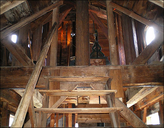 The Old Parish Church is located across the street from the Vermont Country Store. Built in the early 1800’s with the tower clock added in 1882 it’s a typical example of early New England churches. The only way to get to the clock is to climb a ladder up to a trap door that goes to the church attic. From there a set of stairs leads up to the tower. As it turns out the stairs to the tower are the easy part. Lifting oneself up from the ladder through the trap door into the attic is the much more difficult part. A second flight of stairs leads to the belfry where the original bell is located, although no longer connected to the clock. Above the bell are the clock dials, attached to the clock by an iron rod that drives the hands. The George Stevens clock is made of cast iron with brass and iron gears. Cable runs from the drum driving the great wheel over two pulleys to a weight that drives the clock. Originally the weight consisted of a wooden box holding 400 pounds of rocks. As the wooden box tended to bind in the weight shaft it was replaced with a metal barrel when the clock was dismantled and cleaned in 1999. The barrel leaves plenty of room for it to travel up and down the shaft without bumping the edges, much more practical while still containing the original 400 pounds of rocks.
The Old Parish Church is located across the street from the Vermont Country Store. Built in the early 1800’s with the tower clock added in 1882 it’s a typical example of early New England churches. The only way to get to the clock is to climb a ladder up to a trap door that goes to the church attic. From there a set of stairs leads up to the tower. As it turns out the stairs to the tower are the easy part. Lifting oneself up from the ladder through the trap door into the attic is the much more difficult part. A second flight of stairs leads to the belfry where the original bell is located, although no longer connected to the clock. Above the bell are the clock dials, attached to the clock by an iron rod that drives the hands. The George Stevens clock is made of cast iron with brass and iron gears. Cable runs from the drum driving the great wheel over two pulleys to a weight that drives the clock. Originally the weight consisted of a wooden box holding 400 pounds of rocks. As the wooden box tended to bind in the weight shaft it was replaced with a metal barrel when the clock was dismantled and cleaned in 1999. The barrel leaves plenty of room for it to travel up and down the shaft without bumping the edges, much more practical while still containing the original 400 pounds of rocks.
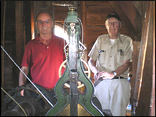 When I arrive in Weston on August 27th bearing a 100 foot reel of 3/16” 7X7 GAC cable and half a dozen spray cans of Grignard’s Prelube 6, the doors to the Old Parish Church are open but no one is in sight. It’s 11:00 A.M. and the tower clock reads 12:00 P.M. I look around and wait for a bit before deciding that I must have somehow missed John when out of nowhere someone appears. “Your name Griswold by any chance”, he asks. “Yup”, that’s me” I reply in my best Vermont dialect, (harking back to my school days). “I’m Tim Goodwin. If you look up to the window of the church tower, that’s where John Soderberg is”. “Got cable for him”, I say. “Gotta get a tool from my truck and we’ll go meet him”, says Tim. Tim and I head up the ladder to the attic, handing the cable and lube up to John first, then up the stairs to the clock itself.
When I arrive in Weston on August 27th bearing a 100 foot reel of 3/16” 7X7 GAC cable and half a dozen spray cans of Grignard’s Prelube 6, the doors to the Old Parish Church are open but no one is in sight. It’s 11:00 A.M. and the tower clock reads 12:00 P.M. I look around and wait for a bit before deciding that I must have somehow missed John when out of nowhere someone appears. “Your name Griswold by any chance”, he asks. “Yup”, that’s me” I reply in my best Vermont dialect, (harking back to my school days). “I’m Tim Goodwin. If you look up to the window of the church tower, that’s where John Soderberg is”. “Got cable for him”, I say. “Gotta get a tool from my truck and we’ll go meet him”, says Tim. Tim and I head up the ladder to the attic, handing the cable and lube up to John first, then up the stairs to the clock itself.
John Soderberg and Tim Goodwin
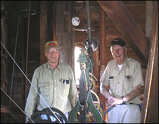 Tim Goodwin grew up in Weston and went to the University of Vermont in Burlington, served in the U.S. Army with a tour in Viet Nam, then moved on to a career with the IRS. While he worked mostly out of Montpelier and Brattleboro, he returned to Weston in 1980 where he and his wife purchased his childhood home from his mother. Tim retired from the IRS in 2002 and is currently the Financial Secretary of the Old Parish Church.
Tim Goodwin grew up in Weston and went to the University of Vermont in Burlington, served in the U.S. Army with a tour in Viet Nam, then moved on to a career with the IRS. While he worked mostly out of Montpelier and Brattleboro, he returned to Weston in 1980 where he and his wife purchased his childhood home from his mother. Tim retired from the IRS in 2002 and is currently the Financial Secretary of the Old Parish Church.
After serving in the U.S. Navy during World War II, John Soderberg spent 30 years with the Navy Underwater Sound Lab in New London, Connecticut. He and his wife retired to Weston in 1975 where they became members of the Old Parish Church and where John is now the Treasurer. In 1999 the tower clock needed attention so John, Tim and others dismantled and cleaned all the gears, removing many years of dirt and grime. By 2000 the clock was running and John began making weekly trips to the tower to wind the cable on the drum. Perhaps easier when he first began the process, one would think it might be something of a burden by now, but John shows no signs of it, even as he nears his ninetieth birthday this November. While never trained as a clockmaker John has nevertheless made enough fine adjustments so the clock stays accurate to within one minute per month.
Installing the Cable
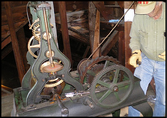 An impressive mechanical wonder the clock is in fine shape, only wanting for a cable to drive it. Turns out installing the cable is going to be a bit of a trick. The reel has a 7/8” diameter hole through the flange and a hole just slightly larger than the cable in the drum. Since we had swaged a ball on one end of the cable, the other end had to be fed through the flange then up through the small hole in the drum.
An impressive mechanical wonder the clock is in fine shape, only wanting for a cable to drive it. Turns out installing the cable is going to be a bit of a trick. The reel has a 7/8” diameter hole through the flange and a hole just slightly larger than the cable in the drum. Since we had swaged a ball on one end of the cable, the other end had to be fed through the flange then up through the small hole in the drum.  After many unsuccessful attempts; multiple trips to John’s and Tim’s houses for additional tools; finally resorting to drilling the hole in the drum larger; some hours later the cable is fed through the holes, up and over the pulleys hanging from the rafters, through the pulley attached to the barrel then back up over a beam and secured with wire rope clamps. The rocks, which had been removed from the barrel and stored in the original wooden weight box, are put back into the barrel. Tension is put on the cable to raise the barrel enough to remove the blocks holding it above the shaft, and then lowered down the shaft to insure it is working correctly. Everything looks fine so the clock is wound bringing the barrel all the way up the shaft to just under the roof rafters.
After many unsuccessful attempts; multiple trips to John’s and Tim’s houses for additional tools; finally resorting to drilling the hole in the drum larger; some hours later the cable is fed through the holes, up and over the pulleys hanging from the rafters, through the pulley attached to the barrel then back up over a beam and secured with wire rope clamps. The rocks, which had been removed from the barrel and stored in the original wooden weight box, are put back into the barrel. Tension is put on the cable to raise the barrel enough to remove the blocks holding it above the shaft, and then lowered down the shaft to insure it is working correctly. Everything looks fine so the clock is wound bringing the barrel all the way up the shaft to just under the roof rafters.
The Old Parish Church Clock Runs
 Tim’s watch now reads 3:47 P.M. John’s watch and my watch read 3:48 P.M. John sets the clock to 3:48 P.M. and starts it going with a small push of the 11 foot long, 110 pound pendulum. It ticks……. and tocks. We stand and listen and watch for a minute or two then take pictures with smiles all around. I climb down the stairs and the ladder, go outside, and take a picture of the church with the George Stevens clock dial now reading 3:56 P.M.
Tim’s watch now reads 3:47 P.M. John’s watch and my watch read 3:48 P.M. John sets the clock to 3:48 P.M. and starts it going with a small push of the 11 foot long, 110 pound pendulum. It ticks……. and tocks. We stand and listen and watch for a minute or two then take pictures with smiles all around. I climb down the stairs and the ladder, go outside, and take a picture of the church with the George Stevens clock dial now reading 3:56 P.M.
Contact us if you know of a worthy project that could use some of the world’s highest quality aircraft cable or wire rope. LoosCo.com would be happy to aid in a worthy cause. Stay tuned for more Restoration Projects!



